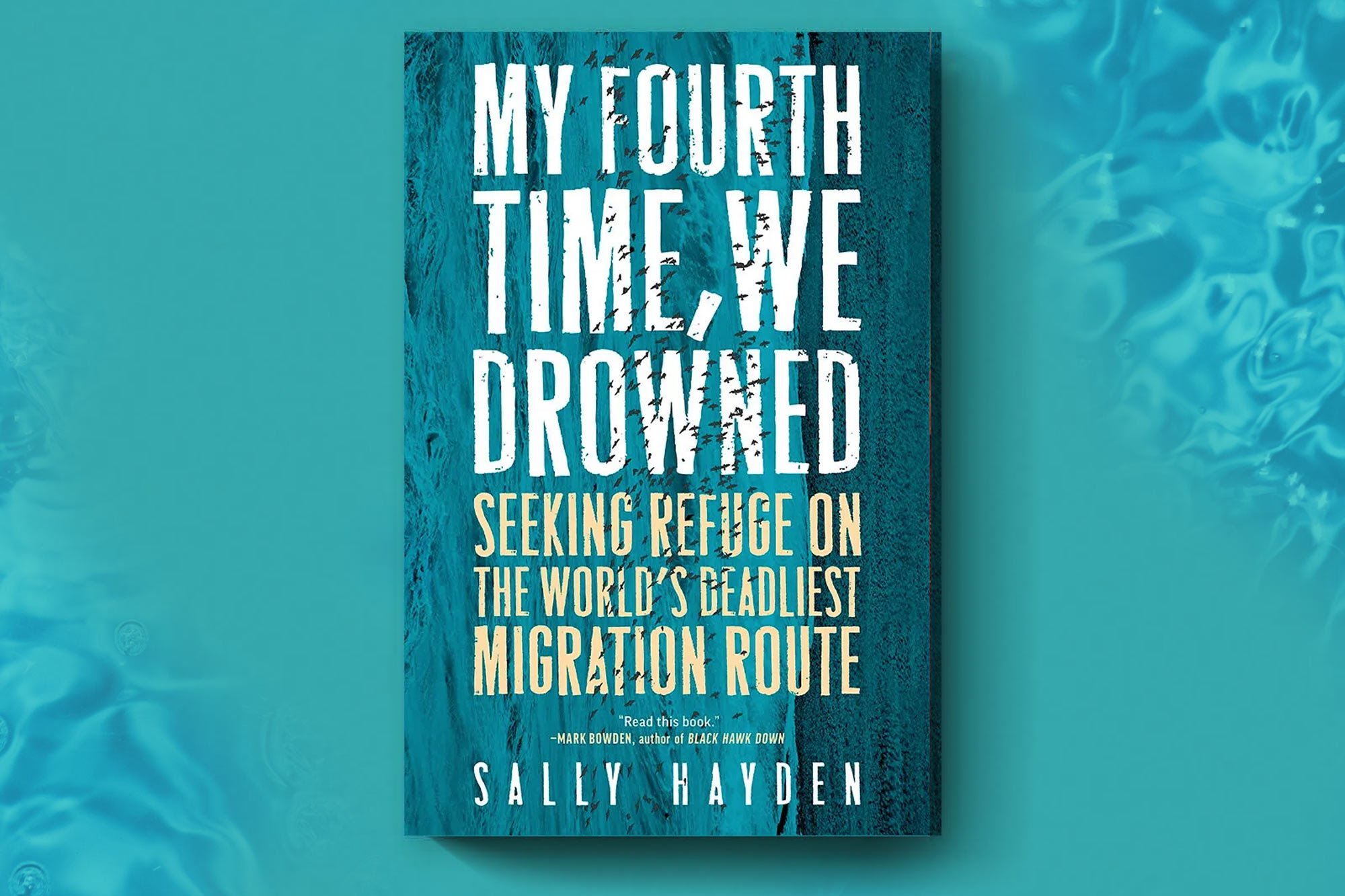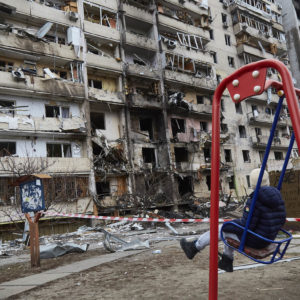New Books | The world’s deadliest migration route
If they don’t drown, migrants sent back from their attempts to cross the Mediterranean Sea are often left to languish in detention centres, sometimes for years at a time.
Author:
2 May 2022

This is a lightly edited excerpt from My Fourth Time, We Drowned: Seeking Refuge on the World’s Deadliest Migration Route by Sally Hayden (Melville House, 2022) with the permission of Melville House Publishing.
Where it ends and where it begins
After 10 hours at sea, Kaleb, a teenager from Eritrea, appealed to God for a sign. He was crouched in the middle of an overcrowded rubber boat, which was being thrown about by waves. His limbs were frozen still, apart from the occasional muscle spasm, and his fingertips had wrinkled. He could taste salt, though maybe this was not as much the spray as the sweat of unwashed bodies around him.
The sea was dark, the water cold. Some of the hundred people in the boat were crying softly, stomachs heaving as they retched from seasickness. Women would occasionally shout out, clutching their children as they beseechingly praised the Lord. Others had stopped making any sound at all. A passenger fainted, her weight on Kaleb. Around them, pooled seawater mixed with vomit. Every big wave was an insistent reminder that many of them could not swim.
Most of the men were perched sideways on the edge of the boat, with one foot in the water. They had taken off their shoes on the shore, or thrown them in the sea, so they were not weighed down and to avoid puncturing the rubber. The tired engine was another potential hazard: any leaking fuel combined with saltwater would cause vicious burns. Fed up or frightened, one man lit a cigarette, and others began to argue, begging him to put it out. They had one satellite phone on board, provided by the smugglers. Once they reached international waters, they dialed a number, as instructed, and asked for a rescue.
As Kaleb prayed, he heard a hum, and then a whirring. It was a small passenger plane, one he felt certain must have been sent by Europe. Its appearance signalled hope for the teenager and his fellow travellers. High above them, the plane began to circle. Its crew had spotted their dinghy, so small it looked almost invisible. The boat’s white rubber merged with the Mediterranean Sea as it lurched, the souls upon it specks of dust. The Central Mediterranean was the deadliest migration route in the world. All those lives, wildly adrift, could have easily disappeared without any trace. Did the plane’s crew think about that?
Related article:
Next, a helicopter arrived. It began to circle, too, before flying a slow path in another direction. “They are leading the way,” Kaleb thought, anticipating a rescue ship ahead and European volunteers, their arms outstretched, ready to greet them. “It is taking us to where the safe boat is.”
Though he was still so young, Kaleb had spent years getting to this point. But with success in sight, he was about to be thwarted. A message had been relayed. The next people he saw were the EU-funded Libyan coastguard – rough, uniformed men who powered towards them on a motorised ship. Kaleb recognised their red, black and green flag, though others wondered aloud if it was Turkish or Tunisian. The Libyans carried weapons and were prepared to use them. There was no resistance as they ordered the refugees off the rubber dinghy. People who had not moved their limbs in hours were suddenly thrashed into activity, each stiff and frigid body part starting rudely and painfully awake. Their thin bodies were forced down low onto the new boat’s deck, and they cowered, surrounded by volatile men with weapons – a position they had been in many times before.
They had not realised they could be taken back to Libya, the country from which they were trying to escape. This, along with the role the plane and helicopter had played by illuminating their position for the interception, dawned on each refugee in turn. It was painful, but even more crushing than this European treachery was the death of a dream. This could have finally been their moment, their chance.
It was 2018, and Libya was a war zone where refugees and asylum seekers were locked up indefinitely without charge or trial. Kaleb’s interception at sea marked the crushing culmination of all the time and more than $10 000 he had paid out while attempting to reach safety. His hopes were obliterated by hardening European migration policy at its most brutal.
On the journey back to North Africa, Kaleb’s thoughts whirled. His family were fated to try and try, but they would never join the ranks of the world’s privileged people: those who could flee a war by plane; those who had a passport or the documents needed to apply for university; those who did not fear a pounding on the door in the middle of the night, a gun in the face, and the understanding you would never be spoken of again. History was repeating itself. Kaleb’s father had made a similar trip before him in 2012, after decades of obligatory, unending military service and a lengthy separation from his family. Already middle-aged, he had set out for Israel, taking an earlier migration route well-travelled by Eritreans. Instead of reaching his promised land, he died in Egypt’s Sinai Desert – of hunger, lack of water or sheer exhaustion, Kaleb never knew.
Related article:
The small country of Eritrea, with its roughly 6 million people, is often referred to as the “North Korea of Africa” by the Western media. It is one of the most secretive and brutal places on earth, where citizens experience their lack of freedom as something physical and stifling. On the Reporters Without Borders 2021 press freedom index, it was ranked as the least free state in the world, behind North Korea itself and other countries well known for oppressing and jailing journalists, like Iran, Egypt and Syria. Yet Kaleb’s people were survivors and freedom fighters. They had battled for decades against European colonisers, as well as their much larger, oppressive neighbour Ethiopia, which was constantly trying to secure access to the Red Sea coast by bulldozing through the small state’s independence.
Eritrea became an Italian colony in 1890. During World War II, the British defeated the Italians there and the UK took charge for the next decade. The US located a spy station in Eritrea after realising it was possible to monitor nearly half the world’s radio waves from its highlands. The station was used to intercept information leading to the Normandy landings and again during the Korean War, with the US arguing that Eritrea should not be allowed to have the independence its people desperately desired because of its strategic location. In 1952, Eritrea, which is also bordered by Djibouti and Sudan, was subsumed by Ethiopia.
During a 30-year-long war of independence, Eritrea’s tegadelti – male and female freedom fighters – lived in trenches, sang revolutionary songs and took classes on democracy as well as battle tactics. Around 65 000 of them were killed before Eritrea achieved statehood in the early 1990s. Isaias Afwerki, a former liberation fighter, took control. Like many other leaders across the African continent, he initially preached people power, even as he transitioned into an autocrat and refused to allow elections. Under him was an army of young slaves. After sovereignty came, Eritrea’s education system was run by ex-independence fighters, with a command style system of management that funnelled students into the army and national service indefinitely.
Independence did not lead to freedom. By 2014, the UN Human Rights Council announced that around 6% of Eritrea’s population had fled the country. The following year, 39 000 Eritreans crossed the Central Mediterranean to Italy – more than one quarter of all arrivals there by sea. In 2016, the UN body said crimes against humanity had been committed in “a widespread and systematic manner” across Eritrea, in military training camps, detention facilities and elsewhere. People who were caught trying to escape described being incarcerated for years. Some prisons were underground, others, like one that survivors said included a roasting hot torture chamber for political detainees known as “the oven”, were facilities specifically designed for interrogation.
Related article:
“Crimes of enslavement, imprisonment, enforced disappearances, torture, persecution, rape, murder and other inhumane acts have been committed as part of a campaign to instil fear in, deter opposition from and ultimately to control the Eritrean civilian population,” the UN report read.
“Eritrea is an authoritarian state. There is no independent judiciary, no national assembly and there are no other democratic institutions,” added Mike Smith, the chair of the Commission of Inquiry. “This has created a governance and rule of law vacuum, resulting in a climate of impunity for crimes against humanity to be perpetrated over a quarter of a century. These crimes are still occurring today.” Kaleb’s childhood memories are laced with his family. Sweet grandparents. Capital city Asmara, with its fading Italian colonial architecture. Cyclists everywhere, because it is almost impossible to import cars.
It is rare that journalists have been allowed inside Eritrea, and much of its population has no access to the internet. Even when a person does manage to get online, maybe in one of Asmara’s few internet cafes, the connection is incredibly slow. In 2012, the UN’s International Telecommunication Union called Eritrea the least technologically connected country on earth. Citizens who escaped its borders had to come to terms not only with what they could see and hear in person – new landscapes, languages and ways of life – but also everything they could now access online. The internet opened up their eyes to the rest of the world, to the full spectrum of human existence and previously inconceivable prospects, in a way that could feel both inspiring and crushingly overwhelming.



